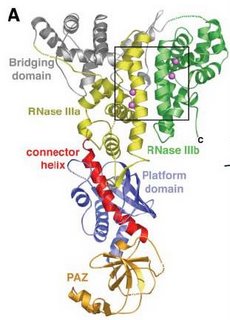The role of PACT in the RNA silencing pathway
But within the functional differences of siRNA and miRNA, multi-domain ribonuclease Dicer and the effector complex, RNA-induced silencing complex, serves as basal participators. In year 2005, Scientists found two factor, hAgo2 and TRBP, participated in the action of RISC on recognition and degradation of mRNA.
Scientists from Korea reported on The EMBO Journal early this year that they found a new dsRNA-binding protein, PATC, which used to be recognized as an activator of protein kinase R and shared similar domain structure with TRBP, interacted with Dicer and hAgo2 in vitro. Further studies using mutants and coimmunoprecipitation show that the third dsRBD of PACT may be responsible for its interaction with Dicer. Similar protocol was used to find the interaction of hAgo2 and PACT. Results indicated that the binding function of PACT with hAgo2 by different domain independently from that with Dicer. In vitro experiment revealed that PACT, TRBP and Dicer associated in the mRNA slicer activity. Results of RNA interference against PACT and TRBP both indicated their participation in RNA silencing pathway, while PACT may perform less than TRBP. Finally, researchers indicated that PACT was involved in accumulation of mature miRNA in HeLa cell line.
From all the results above the author of this article present the fact that human Dicer may associate with two dsRNA-binding proteins, PACT and TRBP. PACT may play a role at RISC assembly, but have no function on pre-miRNA cleavage.
Within this article, the present of PACT with certain roles in a ~500kDa complex provide more knowledge about RNA-associated silencing. This achievement helps us to explore further cross-talking signals and relation of functional factors involved in RNAi, even provide a new field for epigenetic researches and prospects for epigenetic therapy.



